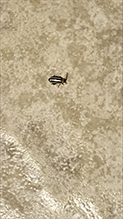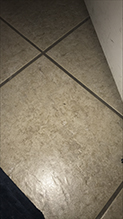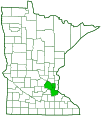pigweed flea beetle
(Disonycha glabrata)
Conservation • Description • Habitat • Ecology • Distribution • Taxonomy
Conservation Status |
|
|||||||
| IUCN Red List | not listed |
|||||||
| NatureServe | NNR - Unranked |
|||||||
| Minnesota | not listed |
|||||||
Description |
||
Pigweed flea beetle is a small beetle, a moderate-sized leaf beetle, and a relatively large flea beetle. It occurs in North, Central, and South America. In the United States it occurs from Massachusetts to Florida, west to Kansas and eastern Texas, with a disjunct population in southern Arizona, and just a handful of records scattered across the rest of the country. It is uncommon in Minnesota. Adults are somewhat shiny, slender, oblong, 3⁄16″ to ¼″ (5.4 to 6.5 mm) in length, and ⅛″ (2.8 to 3.4 mm) wide. The head is yellow and black. Behind the eyes it is covered by the pronotum. The eyes are not notched. The space between the eyes is more than half the width of the head. The antennae have 11 segments. They are black and relatively long but less than half as long as the body. The basal segments are pale. The third segment is shorter than the fourth or fifth. The exoskeletal plate covering the thorax (pronotum) is about twice as wide as long and widest at the base, nearly as wide as the hardened forewings (elytra). On each side the rear corner is distinctly cut off at an oblique angle, which puts the corner at a distance from the elytron. The lateral margin is bowed outward, narrowly flattened, and sharp. There is a slight depression in the middle of the pronotum near the base. The pronotum is red and shiny with a whitish margin. There is a small, distinct, elongated, black spot in the middle and sometimes a smaller, less distinct, round spot on each side. The elytra are oblong with parallel sides, rounded in the shoulder (humeral) region, and broadly rounded at the tip. They have a narrow, flattened margin that does not extend all the way to the tip. The surface is smooth, shiny, and hairless. It is distinctly and densely covered with pits that are not in rows. On the female there is no trace or only a faint trace of longitudinal ridges. Each elytron is yellow or dingy white (pale) with a broad black stripe in the middle that does not quite reach the tip, a black stripe on the inner margin (sutural) that does extend to the tip, and a narrow black outer margin that also reaches the tip. The flattened part of the outer margin is also black. The plate between the wing bases (scutellum) is triangular and black. The legs are slender, relatively short, and variable in color. They are usually mostly pale, either red or yellow, but the amount of black varies. The tips of the third segment (femur) and fourth segment (tibia) are black, and the femur near the outer (distal) end is black on the upper surface. Sometimes the legs are mostly or even entirely black. The tibiae on the front leg does not have a spur at the tip. The femurs on the hind leg is enlarged and modified for jumping. The tibiae on the hind leg is shallowly grooved and has a short spur at the tip. The last part of each leg (tarsus), corresponding to the foot, has five segments. The fourth segment is very short and is concealed within the broadened tip of the third segment, making the tarsus appear to have only four segments. The last segment is not swollen. On the hind leg the first tarsal segment is less than half as long as the tibia. There is a pair of widely diverging claws at the tip of the tarsus. Each claw has a short wide tooth at the base (appendiculate). |
||
Size |
||
Length: 3⁄16″ to ¼″ (5.4 to 6.5 mm) Width: ⅛″ (2.8 to 3.4 mm) |
||
Similar Species |
||
Habitat |
||
|
||
Ecology |
||
Season |
||
May to September |
||
Behavior |
||
|
||
Life Cycle |
||
|
||
Larva Food |
||
|
||
Adult Food |
||
Pigweed (Amaranthus spp.) |
||
Distribution |
||||
|
Sources |
|||
| 10/11/2022 | ||||
Occurrence |
||||
|
||||
Taxonomy |
|||
Order |
Coleoptera (Beetles) | ||
Suborder |
Polyphaga (Water, Rove, Scarab, Long-horned, Leaf, and Snout Beetles) | ||
Infraorder |
Cucujiformia | ||
Superfamily |
Chrysomeloidea (leaf beetles and allies) | ||
Family |
Chrysomelidae (leaf beetles) | ||
Subfamily |
Galerucinae (skeletonizing leaf and flea beetles) | ||
Tribe |
Alticini (flea beetles) | ||
| Subtribe | Disonychina | ||
Genus |
Disonycha | ||
Synonyms |
|||
|
|||
Common Names |
|||
pigweed flea beetle |
|||
Glossary
Elytra
The hardened or leathery forewings of beetles used to protect the fragile hindwings, which are used for flying. Singular: elytron.
Femur
On insects and arachnids, the third, largest, most robust segment of the leg, coming immediately before the tibia. On humans, the thigh bone.
Pronotum
The exoskeletal plate on the upper side of the first segment of the thorax of an insect.
Scutellum
The exoskeletal plate covering the rearward (posterior) part of the middle segment of the thorax in some insects. In Coleoptera, Hemiptera, and Homoptera, the dorsal, often triangular plate behind the pronotum and between the bases of the front wings. In Diptera, the exoskeletal plate between the abdomen and the thorax.
Tarsus
On insects, the last two to five subdivisions of the leg, attached to the tibia; the foot. On spiders, the last segment of the leg. Plural: tarsi.
Tibia
The fourth segment of an insect leg, after the femur and before the tarsus (foot). The fifth segment of a spider leg or palp. Plural: tibiae.
Visitor Photos |
|||||
Share your photo of this insect. |
|||||
| This button not working for you? Simply email us at info@MinnesotaSeasons.com. Attach one or more photos and, if you like, a caption. |
|||||
Jackie Holguin |
|||||
 |
 |
||||
MinnesotaSeasons.com Photos |
|||||
|
|||||

Slideshows |
||

Visitor Videos |
|||
Share your video of this insect. |
|||
| This button not working for you? Simply email us at info@MinnesotaSeasons.com. Attach a video, a YouTube link, or a cloud storage link. |
|||
Other Videos |
|||
| Pigweed Leaf Beetle (Disonycha glabrata) Escarabajo Caramelo VideotecaFaunaPR |
|||
About
Jul 10, 2018 Este pequeño (~4 mm) coleóptero de la familia Chrysomelidae habita en los bosques americanos, desde Canadá hasta Brasil, incluyendo las Antillas. Exhibe antenas relativamente cortas y ojos pronunciados. Tiene patrones simétricos de colores muy brillantes y cuerpo que pareceriera estar lacado; de ahí su nombre común porque parece a un tipo local de bombón glaseado. Es noctámbulo y se alimenta de hojas, razón por la cual se le considera una plaga. Filmado en Cayey. Google Translate: This small (~4 mm) beetle of the Chrysomelidae family inhabits American forests, from Canada to Brazil, including the Antilles. It exhibits relatively short antennae and pronounced eyes. It has symmetrical patterns of very bright colors and a body that seems to be lacquered; hence its common name because it resembles a local type of glazed bonbon. It is nocturnal and feeds on leaves, which is why it is considered a pest. Filmed in Cayey. |
|||

Created: 10/11/2022
Last Updated:


